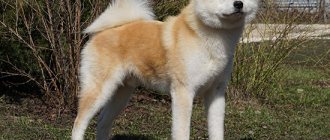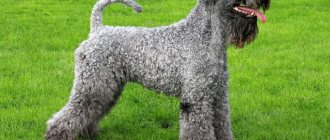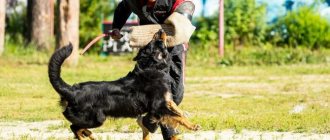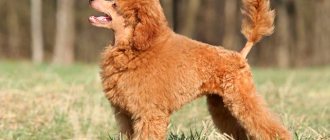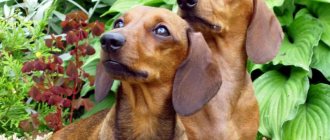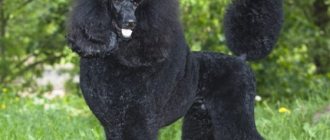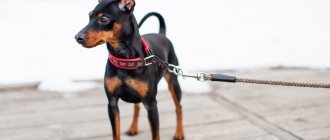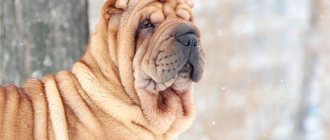The breed to which the pet belongs determines not only its appearance and character, but also its needs regarding nutrition, living conditions and care.
It should be noted that caring for a pet is not at all difficult.
A loving, caring owner will make every effort to provide his four-legged friend with everything he needs and maintain his good health.
Speaking about the Akita Inu, it is worth noting that care, which, in the opinion of many, seems labor-intensive, is in fact enviably simple.
Are they difficult to care for?
Caring for an Akita Inu is not difficult . Unpretentious by nature, dogs are not prone to whims in nutrition and eat both natural products and industrial food equally well.
Coat care does not require mandatory haircuts or trimming and is limited to regular combing and occasional washing.
Long active walks are what Akita Inu really needs . It is important to allow your pet to waste its energy; this has a positive effect on its development and health.
You don’t have to come up with complex, original games; the dog will be happy to simply bring the owner a ball or a found stick.
History of the breed
The history of the Akita Inu is very interesting; this breed is one of the 14 oldest breeds in the world. These are not just words or legends, this fact was proven by scientists who studied the dog's pedigree in detail and conducted genetic research. Also, the antiquity of this breed is evidenced by the remains that were found on the territory of modern Japan and date back to approximately the 2nd millennium BC. In addition, ancient drawings were discovered depicting a dog very similar in appearance to the modern Akita Inu.
The Japanese decided not to waste a lot of time and imagination on coming up with an original name for the breed. Translated from Japanese, “inu” means “dog”, and “akita” is the name of a mountainous province in the northern part of the island of Honshu. The first dogs with a fully formed appearance appeared in that area back in the 17th century, and their appearance has remained unchanged to this day. They were favorite pets of the most influential statesmen, royalty and even emperors.
This is one of the few breeds that is truly “pure breed” without “admixtures” of new blood. Initially, the Akita was a favorite guard in peasant houses and an excellent hunter, but in the 18th century the dogs changed their class affiliation and became “elite”. A law was passed stating that a person who dared to offend or kill an Akita Inu would be subject to severe punishment. After some time, this breed was available only to members of the imperial family and the ruling aristocracy.
It is worth noting that this fact greatly affected the development of the breed as a whole. Keeping, feeding and caring for an Akita has become a special ceremony. Each dog had its own personal servant, and special leashes and collars were made for them, by which the rank of the dog and the social status of its owner could be determined. Everything around had to correspond to the respect that the Akita enjoyed.
In 1927, the Akita Inu Preservation Society was created. This was done in order to preserve the pure breed and to prevent the Akita from being crossed with other dogs. During World War II, most Akita Inus were sent to the front for military use. In those days, Akita breeding stopped a bit due to lack of food and funds for maintenance. In Japan, only a few purebreds were preserved, but despite this, the breed survived the post-war period and managed to retain all its natural qualities.
It is believed that the ancestor of the Akita was a Chinese Spitz dog mixed with mastiff blood. There is also another theory that the beautiful Akita was created by mixing a Siberian Husky and a Mastiff. Although the Akita is somewhat similar to the Russian Laika, they have nothing in common.
In the 19th century, a huge number of other breeds poured into Japan (Great Danes, Bulldogs, St. Bernards). The Japanese wanted to create a more aggressive breed that could protect not only their family, but also their property. Today it is impossible to say for sure that inbreeding somehow influenced the appearance and characteristics of the Akita, but thanks to these crossings, breeds such as the Karafuto and Tosa Inu appeared. Over the past 50 years, the Akita Inu has also changed a little, with a more powerful and dense build, as well as more aggression and temperament.
How to care for a puppy
The first thing you need to do is show the puppy his personal place, which should already be arranged . If it’s warm outside and you plan to keep your pet in an enclosure, you can immediately place the puppy in it, otherwise you need to show him a place in the house.
CAREFULLY!
You cannot change the puppy's diet for several weeks - he should eat the same food as the breeder gave him.
Puppies should not carry heavy objects or run a lot until about 1.5 years of age, when their joints are stronger.
Hygienic care includes regular combing of the coat, trimming of nails, cleaning of teeth and ears..
It is necessary to accustom the puppy to these procedures from an early age.
An adult dog
You should follow the vaccination schedule, promptly treat for internal and external parasites, feed your pet a balanced diet - all these factors affect the pet’s health and its life expectancy.
In general, caring for an Akita Inu is almost identical to caring for other breeds and consists of brushing the coat, brushing teeth and ears, and trimming nails..
Adult Akitas are still energetic and active and need regular long walks. Perhaps this is one of the key conditions for proper and caring care for a pet of this breed.
Training or how to raise an Akita Inu
This is not a mini dog that you can put clothes on and just play, but the process of training an Akita Inu requires a lot of patience and endurance. The upbringing of this large dog is slow; each representative of this breed requires a certain approach and attention. It is not recommended to raise it as a guard dog. The dog develops very slowly and finally matures only at two years of age. Her laziness can easily give way to a playful attitude. The character of each individual of this breed must be carefully studied and then it will bear fruit. Breeders begin training from an early age.
Vaccination schedule
| Age | Vaccine option |
| 8-9 weeks | Nobivac DHPPI + Nobivac L Eurican DHPPI + Eurican Duramune Max5-CvK/4L |
| 12 weeks | Nobivac DHPPI + Nobivac L+R Eurican DHPPI + Eurican L+R Duramune Max5-CvK/4L(+ after 21 days Nobivac R) |
| At 1 year and annually thereafter | Nobivac DHPPI + Nobivac L+R Eurican DHPPI + Eurican L+R Duramune Max5-CvK/4L (+ after 21 days Nobivac R) |
You cannot vaccinate an unhealthy puppy, and 10 days before vaccination it is necessary to carry out deworming.
Expert opinion
Kozhevin Semyon Kirillovich
Expert dog handler.
Akita Inus are suitable for active people who have free time, as they need long, active walks. It is also necessary to feed these dogs correctly, taking into account the characteristics of their body and health. These are the 2 main components of proper care that allows you to raise a strong, healthy dog. Grooming also includes brushing the fur, trimming the nails, and cleaning the teeth and ears.
What you need to prepare
You should purchase products in advance to help ensure proper care for your dog.:
- wide-toothed comb;
- slicker;
- massage comb or brush with natural bristles;
- toothpaste;
- collar and leash;
- nail clipper;
- 2 bowls on a stand;
- toys;
- veined bone;
- a bed, bedding or rug;
- muzzle;
- feed;
- shampoo and conditioner;
- disposable hygiene diapers.
Cotton swabs, napkins, and towels for washing your pet can always come in handy.
First days at home
Finding itself in an unfamiliar environment, the puppy experiences stress, so it is important to ensure a calm, quiet environment in the house: you should not invite guests, play music loudly, if there are children, you should not allow them to grab the puppy.
The dog needs time to adapt and also to get used to its name.
The puppy is scared and may whine and ask to be held. You can soothe him in your arms, but you should not carry him constantly, otherwise he will never become independent.
At night, the pet may ask to go to bed with its owner, believing that this is the only safe place.
If you do not plan to allow an adult dog to sleep in the owner's bed, you should not allow the puppy to do so either . It is better to place his bed near the bed and touch the puppy when he whines.
To quickly adapt, you should not leave the puppy in the house alone, but if this is necessary, you need to limit its space by locking it in the smallest room and leaving it with toys.
The character of the “Japanese samurai”
The character of the breed is no less unique, because it was formed over hundreds of years. Initially, the Japanese Akita Inu dog was a brave hunter, and later a devoted guard. Love, respect and reverent attitude on the part of the owners allowed the dogs to understand the psychological side of a person, to capture his mood and emotions.
The behavior and character of Akitas is quite atypical. As puppies, dogs are more like children, they are playful and inquisitive, loving attention. As they grow up, they become more restrained; the pet’s gaze is imbued with wisdom and sincerity.
Experts who have been breeding this breed for a long time claim that the character of the Akita Inu is built on complete exceptions and paradoxes, which still surprises even the most experienced breeders. For example, they do not like to walk on a leash and will be extremely unhappy if the owner chooses a place for a walk that they do not like. They are self-sufficient and independent, and even somewhat reminiscent of cats that walk on their own. However, they are incredibly attached to their family and owner, so without hesitation they will rush to protect their person.
If you decide that the Akita Inu breed is just for you, then remember the basic rule: the representatives of this clan are equal to you. They cannot be considered as entertainment for children, much less started out of boredom. An Akita can be your friend, a family member, but nothing else.
Personal place
If an Akita Inu lives in a house or apartment, it is necessary to create a place for it in the corner of a closed room, where the dog can sleep or simply relax and hide from the attention of prying eyes.
You need to put there a moderately hard but cozy special bed (blanket or rug), the size of which will allow the dog to stretch out freely during sleep and generally feel comfortable.
Main characteristics
| Breed parameters | |
| Country of origin: | Japan |
| Weight of the breed: | up to 45 kg |
| Height at withers: | males 70 cm, females 60-64 cm |
| Temperament: | active |
| Wool: | average |
| Role in human life: | guard, hunting |
The calm, sociable character and appearance, which is difficult not to fall in love with, have made Akita Inu dogs popular. This is a real national treasure of Japan, where this breed was bred. They repeatedly starred in films, including Hachiko. Before you get an elite puppy, it is important to study all the characteristics of the Akita Inu and whether it can be kept in an apartment.
Feeding and diet
Akita Inu dogs are unpretentious in food, which allows them to be fed with natural products, ready-made industrial food, and even a mixed diet..
However, we should not forget about the likelihood of developing an allergic reaction or food intolerance, as well as the balance of dietary supplements and vitamins and minerals, so the choice of nutrition should be approached responsibly.
A natural diet should include:
- dairy products;
- lean meat;
- boiled offal;
- eggs;
- millet, rice, buckwheat;
- vegetables;
- fruits (after 4 months).
The serving size is calculated based on the pet’s weight: 400-500 g of food for every 30 kg of weight. Natural nutrition involves additional intake of vitamins and minerals - this helps to avoid joint problems in your pet, as well as improve the quality of the coat.
IMPORTANT!
It is necessary to control the amount of protein food, because Excess proteins lead to the development of allergies, characterized by dermatitis and digestive disorders.
In the case of feeding industrial feed, preference should be given only to high-quality products of at least premium class, and better yet, super premium class, since they are made from the most natural ingredients and contain a vitamin and mineral complex.
The number of feedings per day depends on the age of the dog:
- up to 2 months - 5-6 times;
- 2 months - 5 times;
- 3 months - 4 times;
- 4 months - 3 times;
- After six months, you should gradually accustom the dog to feeding twice a day.
In case of low physical activity and light loads, the Akita Inu can eat once every 2 days.
Choosing a puppy
When buying a puppy, you must remember that black color on the face and drooping tail are unacceptable for representatives of this breed.
If there are many puppies born in one litter, you should not buy just one of them. Choose a medium-sized, active and playful baby from a small litter.
Healthy puppies are well-fed, not shy, and not aggressive.
Akita Inu puppies are very temperamental, and only as they mature do they become calm and reasonable.
In raising this dog, the main point is the socialization of the baby. In order for the dog to grow up calm, smart and with a healthy psyche, you will have to work on this issue.
How much do puppies cost?
After the film about Hachiko was shown on the screens, the number of people wanting to buy this dog for themselves increased fifteenfold!
How much an Akita Inu puppy will cost you will depend on what kind of baby you buy.
For example, a dog without documents can cost from fifteen to thirty-two thousand rubles. At the same time, a representative of the show class will come out within fifty, one hundred thousand rubles.
How often should you go for walks?
You need to walk your Akita Inu at least 2 times a day for 2 hours. At the same time, it is still better if there are more walks and they last longer.
Walking is required not only for domestic dogs, but also for dogs living on the street..
Regular walks, physical activity, active games, training and communication with the owner and other animals (provided the pet does not have zoo aggression) have a positive effect on the health and development of the dog.
Choosing an Akita Inu puppy
To purchase a dog of such a noble breed as Akita Inu, go to the club of the corresponding breed. Ideally, the club should be recognized by the International Canine Organization. When choosing a puppy, rely on the following points: Choose an animal from a small litter, where all the puppies are of medium size. Ask the seller to introduce you to the dog's pedigree. Inquire about the availability of certificates and prizes, as well as possible genetic diseases and allergies. It is not recommended to take a puppy whose parents were closely related, it may be sickly.
An approximate psychological portrait of a puppy can be determined through contact with its parents. A healthy puppy is active, has a good appetite, a playful character, shiny eyes, smooth coat and clean ears. The puppy should not have an unpleasant odor. Teeth and claws must be intact. It is also worth paying attention to the pet’s reaction to you as a potential owner. Curiosity, sociability and a desire to play are signs that a small Akita is ready to accept a new family. If you need a dog for production or championship, it is recommended to seek the help of experienced dog handlers to select one.
Can he live on the street?
Thanks to the structure of the coat and thick, dense undercoat, Akita Inu tolerate cold well and can live outside even in winter, provided several requirements are met.:
- the enclosure should be insulated and located in a place that is not too accessible, but provides sufficient visibility;
- There should be a warm layer of blankets or straw inside the enclosure;
- It is necessary to provide your pet with warm food and water.
You cannot put an Akita Inu on a chain - this is associated in the dog with a loss of freedom and has a negative impact on its mental and physical state.
Diseases and treatment
Each breed of dog has diseases to which representatives of a particular species are more predisposed than others. Akita Inu also has these. First on the list of breed ailments is hip dysplasia. If a dog is intended for selection and breeding, then before the age of 24 months it must be sent for an X-ray examination. The dog must receive a certificate denying the presence of dysplasia. Otherwise, the individual is not suitable for breeding. Unfortunately, this is not the only “sore” that Japanese dogs suffer from.
- Hypothyroidism. Thyroid dysfunction often leads to skin diseases. When the animal is observed by a specialist and the treatment program is unconditionally followed, the function of the thyroid gland is restored, and skin ailments disappear without a trace. It has been scientifically proven that hypothyroidism in Japanese dogs is inherited - from mother to child.
- Congenital eye diseases. Problems with vision and the organs that are responsible for it are also hereditary. Most often, in dogs of this breed, entropion of the eyelid, cataracts, and retinal dysplasia occur. The result of improper treatment or owner's oversight (and, as a consequence, untimely contact with a veterinarian) can be blindness. For this reason, all Japanese dogs are recommended to visit an ophthalmologist once a year.
- Red blood cell abnormalities. Dog breeders should also be aware of this feature of four-legged pets. Their blood contains increased amounts of K+ red blood cells, and this is normal. Ignorance of this feature leads to false diagnoses. For example, hyperkalemia is a condition in which an excessive amount of potassium is detected in the blood of a living being.
- Gastric volvulus. This is a dangerous and common disease in Akita Inu. Prevention consists of frequent feeding in small portions, increased activity immediately after meals and pre-soaking dry food in a small amount of water.
Diaper training
If your dog lives in an apartment and you need to teach it to relieve itself in a diaper, you should:
- take your pet to the diaper immediately after he wakes up or eats;
- at first, keep the puppy in a limited area, where several diapers will be spread on the floor - this leaves the dog practically no alternative and helps to quickly remember where the toilet is;
- if it is impossible to briefly limit the dog’s movements, then you should spread the diapers in several places: near the door, balcony, under the window and in places that the dog has chosen itself, gradually reducing their number.
You can also use special sprays by spraying them on diapers - they emit a specific smell that indicates to the dog that this is a toilet.
You need to accustom your puppy to a diaper from the first days in a new home..
Akita conditions
Akitas are free-spirited dogs, so it is best to get this breed for a private home. But, if the desire to acquire these particular Japanese dogs is too great, you can have an Akita Inu at home . But, in this case, you will have to carefully prepare and think through everything down to the smallest detail:
- Dog's resting place. It is a mistake to think that if an animal is a pet, it does not need its own corner. Be sure to arrange a secluded place where the dog will feel comfortable and protected. But, beware of places where there is a draft or, like a stove, heating batteries.
- Place for feeding. Be sure to decide on this point as soon as you purchase the puppy. It is better if it is not a kitchen, but a quiet and impassable place. It is not advisable to feed the animal in the room or near the house, as you will live in eternal crumbs and leftover food.
- Walks. If an American Akita sits in an apartment around the clock, this is a bad sign. Walk your dog at least twice a day, morning and evening, and if possible even more, for at least an hour. Moreover, this should not be a monotonous walk, as if you were going to the theater in full dress, but rather active exercise with physical exercise. It would not be amiss to visit specialized dog training grounds and places at least once a week, which are equipped so that the animal can frolic to its heart’s content and keep its muscles in good shape.
- During the cold and dirty seasons, do not forget to keep the animal clean. Although, dogs are famous for their cleanliness, and after each walk they will clean themselves up. Take care of the coat, help during the shedding season, and then keeping an Akita Inu in the apartment will be simple and pleasant! Remember to check the condition of the ears, nails and trim the fur between the paw pads weekly. But you don’t have to think about swimming. It is best to carry out bath procedures twice a year, using special shampoos. Systematic bathing will not only be of no benefit, but will also cause enormous harm to the condition of the animal’s coat. After all, active chemical elements literally wash away the protective layer and fat, making the coat and skin more vulnerable.
The decision to get a dog is quite a responsible and serious one. After all, the life of the animal depends on how prepared you are for this. If you properly prepare and care for your dog, keeping an Akita Inu in an apartment will bring a lot of positive emotions and unbridled joy for all family members.
- Akita inu
- care
If you find an error, please select a piece of text and press Ctrl + Enter.
How to trim claws correctly and when?
Too long nails do not allow the dog to position his paws correctly, which causes the load on the ligaments and joints to be distributed incorrectly, so the nails must be trimmed regularly.
This should be done monthly using a nail clipper designed for large dogs . After trimming, the sharp edges need to be filed with a file so that the claws do not peel off.
The claws must be shortened carefully, without touching the blood vessels or causing pain to the pet, to such a length that the dog does not “clack” on the floor when walking.
How to clean your ears
Akita Inu have open ears, in which dirt, dust and excess wax accumulate. This problem is especially relevant for street dogs.
It is necessary to clean your pet’s ears 1-2 times a week with a cotton pad soaked in a special lotion..
Healthy ears should not have an unpleasant odor, and they should have a pink tint.
Akita Inu character
Akita Inu have the most beautiful character. Dogs of this breed will easily become your best friends. After all, they are quiet, calm, affectionate, and bark only when necessary. This breed is very clean, always clean and without an unpleasant odor. Such dogs are very patient and get along well with children, and have a tendency to protect their owner.
Since the Akita Inu has long been used for hunting and has possessive instincts, it must be accustomed to other animals at an early age. Without this, dogs may behave aggressively towards others, especially dogs of the same sex. But if they grow up, for example, with a cat, they will get along wonderfully with it. They are also excellent guard dogs and very strong protectors. An extremely intelligent, balanced dog, but at the same time independent, stubborn and assertive, but this is only if it does not receive enough stress.
Grooming
Soft, plush-like wool of medium length with a thick undercoat is the calling card of representatives of this breed. At the same time, the coat requires minimal care, which does not take much time.
These dogs do not need any haircuts or trimming..
You need to comb your pet 1-2 times a week, first with a wide-toothed comb, then with a slicker brush to get rid of dead undercoat hairs, and then with a massage comb or a natural bristle brush.
NOTE!
Akita Inu sheds twice a year for several weeks; as a rule, these periods occur in January-February and May-June.
At this time, abundant hair loss occurs, which brings inconvenience not only to the pet, but also to its owner. Daily brushing can improve the situation.
During the molting period, to maintain a healthy coat of the dog, you should give it mineral supplements..
Sterilized animals living indoors or in a climate that excludes major seasonal changes do not shed excessively.
Description of the Akita Inu breed
The Akita Inu is far from a miniature dog breed; it is quite powerful, but at the same time very beautiful, you simply cannot take your eyes off it. The coat is thick and dense, the tail is often thrown behind the back. The Akita Inu has an Asian-type muzzle, large with a long forehead and small erect ears.
Breed standards:
- The weight of an adult female is from 32 to 45 kg, a male is from 40 to 45 kg.
- Height at withers for females is 58-64 cm, for males 64-70 cm.
- Six double with a thick undercoat, the top hair is longer and coarser. The undercoat is very soft, like down. The fur is 5 cm long, but it can be longer on the belly and tail.
- The forehead is wide and has a hollow in the middle. The muzzle is of medium length with a thick base. The lips are black, very dense.
- Akita Inu's eyes
- The ears are not very large, triangular in shape, erect, slightly tilted forward.
- The neck is huge and muscular, the hair on it forms a kind of collar.
- The back is straight, strong, the chest is wide.
- The tail is curled to the top.
- Lifespan Akita Inu from 10 to 12 years old.
Height and weight chart
Representatives of the ancient Japanese breed grow extremely slowly. Only a dog that has reached the age of three can be called fully formed. The table will guide you in the approximate height and weight of the animal at different age periods.
Table - Akita Inu height and weight standards
| Age, months | Height, cm | Weight, kg | Note |
| 6 | 56 | 21 | — The roundness characteristic of puppies disappears; - the dog acquires forms that fully correspond to an adult individual |
| 10 | 62 | 25 | The dog gains from 4 kg to 7 kg per month |
| 12 | 64 | 30 | By this time, the bitches begin to go into heat, but the adult |
Do you need to brush your teeth?
At 4 months, puppies begin to change their teeth and owners need to carefully monitor this process, because if baby teeth fall out untimely, malocclusion may form.
Teeth brushing should be done at least once a week or more often, using specialized toothpastes for dogs . The toothbrush can be an ordinary human one, it does not matter fundamentally.
Paste intended for human use should not be used due to its fragrance and tendency to foam.
How often should I bathe?
Akita Inu are clean dogs and dirt that the pet cannot cope with on its own can be easily removed during brushing. Therefore, bathing is required no more than once a quarter or even less often.
Frequent washing harms the Akita Inu's coat, depriving it of its protective properties..
When bathing, you should use a special shampoo and conditioner that matches your dog's coat type.
The undercoat takes a long time to dry, so after washing your pet you need to dry it with a hairdryer, but so as not to dry out the skin..
